
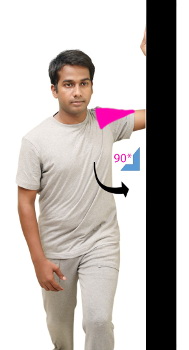
Steps for doing:
- The coloured part in being stretched.
- Lean against the wall as shown in figure
- Elbow abuts the wall
- Maintain an angle of 90 degree between left arm and left side chest wall of the body
- Left Hands supported on the wall
- Only body moves in front by fixing the left shoulder joint
- Hold the same position for 10-20 seconds, without holding your breath
In this video we are going to see deltoid muscle stretching exercise
The coloured part of the muscle is being stretched as shown
The arrow indicates the direction of stretch
- Most importing muscle of shoulder complex
- Helps in lifting the upper limb
- It causes symptoms in the shoulder joint and in the arm
- Symptoms may include pain, numbness, hypersensitivity, altered sensation, irritability, and symptoms related to compression of adjacent blood vessels and nerves.
- May present as weakness of the arm to lift up
- Commonly related to the disease such as rotator cuff tear, tendinitis, bursitis, cervical nerve compression(C5), and shoulder arthritis.

Steps for doing:
- The coloured part in being stretched.
- Hold the towel behind yourself as shown
- Pull the head end of the towel upwards
- For a better stretch hold towel end behind your head and pull it up
- Hold the same position for 10-20 seconds
In this video we are going to see infraspinatus and teres minor muscle stretching exercise
The coloured part in being stretched as shown
The arrow indicates the direction of stretch
- Most commonly involved in shoulder joint dysfunction
- Symptoms may refer to the scapular, shoulder, arm and forearm region, till the ring and little finger
- Symptoms may include pain, numbness, hypersensitivity, compression of adjacent blood vessels and nerves
- Commonly related to disease such as rotator cuff injury, arthritis of shoulder joint, cervical disc syndrome, tendinitis, bursitis and others.
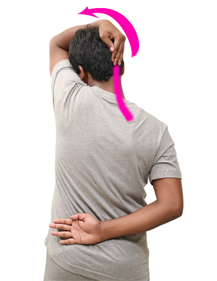
Steps for doing:
- The coloured part in being stretched.
- Keep your right hand behind your body.
- Left hand behind your head and just behind ears as shown
- Pull your head towards left and forward.
- Remember to Tuck your chin towards chest wall.
- See that Head is moved in an arch like fashion towards left side.
- Hold the same position for 10-20 seconds, without holding your breath
In this video we are going to stretch levator scapulae muscle. The coloured part is being stretched as shown. The arrow indicates the direction of stretch
- One of the important muscle responsible for stiff neck.
- Symptoms refer to scapula, shoulder, head and neck region.
- Symptoms may include pain, numbness, hypersensitivity, altered sensation, irritability and symptoms related to compression of adjacent blood vessels and nerves
- Commonly related to disease such as levator scapulae syndrome, stiff neck syndrome, C3, C4, C5 or C6 spinal joint dysfunction and others.
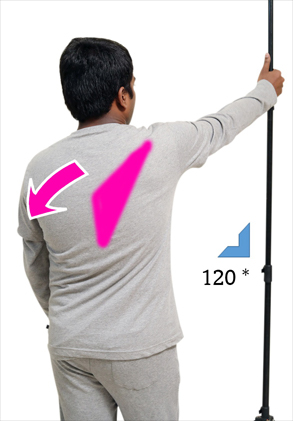
Steps for doing:
- The coloured part in being stretched
- Hold a poll with right hand as shown
- Fall backward by pulling the poll
- Maintain an angle of 120 degree between right arm and right side body
- Hold the same position for 10-20 seconds
In this video we are going to see lower trapezius muscle stretching exercise
The coloured part in being stretched as shown
The arrow indicates the direction of stretch
- It is the major muscle of the body holding the head, neck, upper spine, and the shoulder
- It may be the cause for spinal joint dysfunction
- It may cause symptoms involving the head, neck, upper spine, shoulder, upper limb and scapular region
- Symptoms may include pain, numbness, hypersensitivity, compression of adjacent blood vessels and nerves
- Commonly related to disease such as stiff neck, cervical and thoracic disc prolapse, shoulder dysfunction, spondylosis of spine, scapular dysfunction and others

Steps for doing:
- The coloured part in being stretched
- Position your body as shown.
- See that your right hand supported ,and left upper limb freely hanging down
- Swing left upper limb freely up/ above head, and down / behind your body
- See that only free swinging movements takes place without restriction
- Do 5-10 repetitions for better stretch
In this video we are going to see middle trapezius muscle stretching exercise
The coloured part in being stretched as shown
The arrow indicates the direction of stretch
- It is the major muscle of the body holding the head, neck, upper spine, and the shoulder.
- It is the most common cause for rounded shoulders
- It may be the cause for spinal joint dysfunction
- It may cause symptoms involving the head, neck, upper spine, shoulder and upper limb region
- Symptoms may include pain, numbness, hypersensitivity, compression of adjacent blood vessels and nerves
- Commonly related to disease such as stiff neck, cervical and thoracic disc prolapse, shoulder dysfunction, spondylosis of spine and other disease.
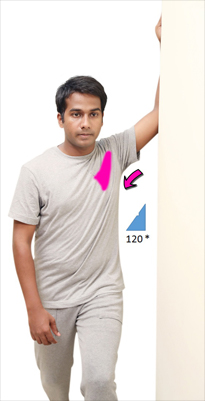
Steps for doing:
- The coloured part in being stretched
- Hold the left upper limb against wall as shown.
- See that the elbow abuts the wall.
- Maintain an angle of 90 degree between your left arm and left side of the body for stretching sternal part of the muscle
- Maintain an angle of 45 degree between your left arm and left side of the body for stretching clavicular part of the muscle
- Body only moves forward by fixing the left shoulder joint.
- Hold the same position for 10-20 seconds
In this video we are going to see pectoralis major muscle stretching exercise
The coloured part in being stretched as shown
The arrow indicates the direction of stretch
- It has two parts - sternal and clavicular head
- Most common cause for chest pain, breathing difficulties and shoulder dysfunction
- Symptoms may include chest wall, shoulder, arm, forearm, until 4th and 5th fingers
- Symptoms may include pain, numbness, hypersensitivity, compression of adjacent blood vessels and nerves
- Commmonly related to cardiac arrhythmias, rib joint dysfunction, costoclavicular syndrome, scalene syndrome, pectoralis minor syndrome, cervical disc syndrome and other disease

Steps for doing:
- The coloured part is being stretched
- The side being stretched should rest on the walls
- Elbow abuts the wall.
- Body only moves front.
- Maintain the angle.

Steps for doing:
- The coloured part in being stretched
- Hold the left upper limb against wall as shown.
- See that the elbow abuts the wall.
- Maintain an angle of 120 degree between your left arm and left side of the body.
- Body only moves forward by fixing the left shoulder joint.
- Hold the same position for 10-20 seconds
In this video we are going to see pectoralis minor muscle stretching exercise
The coloured part in being stretched as shown
The arrow indicates the direction of stretch
- Most common cause that resembles heart attack
- Symptoms usually refer along the chest wall, arm, forearm, hand and the fingers
- Symptoms may include pain, numbness, hypersensitivity, compression of adjacent blood vessels and nerves
- Commonly related disease are carpal tunnel syndrome, epicondylitis, costoclavicular syndrome, cervical nerve compression and others.
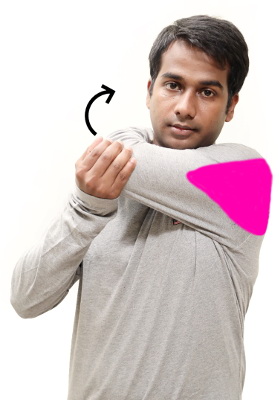
Steps for doing:
- The coloured part in being stretched.
- For left deltoid stretch, left hand supported on opposite shoulder
- Left Elbow raised at the level of neck
- Hold the left elbow with right hand as shown
- Push elbow across neck towards right side
- Hold the same position for 10-20 seconds without holding your breath
In this video we are going to see deltoid muscle stretching exercise The coloured part of the muscle is being stretched as shown The arrow indicates the direction of stretch
- Most importing muscle of shoulder complex
- Helps in lifting the upper limb
- It causes symptoms in the shoulder joint and in the arm
- Symptoms may include pain, numbness, hypersensitivity, altered sensation, irritability, and symptoms related to compression of adjacent blood vessels and nerves
- May present as weakness of the arm to lift up
- Commonly related to the disease such as rotator cuff tear, tendinitis, bursitis, cervical nerve compression(C5), and shoulder arthritis.
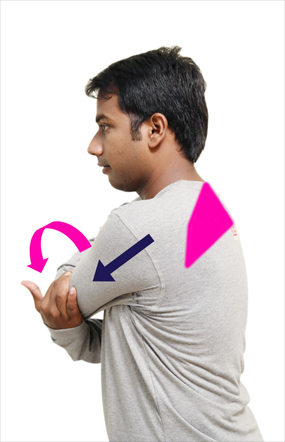
Steps for doing:
- The coloured part in being stretched
- Hold left Elbow region with right hand as shown
- Pull the left Elbow towards right side and downwards
- Rotate the elbow outwards as shown
- Hold the same position for 10-20 seconds
In this video we are going to see rhomboid muscle stretching exercise
The coloured part in being stretched as shown
The arrow indicates the direction of stretch
- Working or sitting without back support is the most common cause
- Most common cause for spinal joint dysfunction from C7, T1, T2, T3, T4, T5.
- Symptoms may involve scapular, and spinal regions
- Symptoms may include pain, numbness, hypersensitivity, compression of adjacent blood vessels and nerves
- Commonly related to disease such as fibromyalgia, tight pectoralis muscle, Rounded shoulder, and spinal joint dysfunction.

Steps for doing:
- The coloured part in being stretched
- Sit over the couch.
- Hold the corner behind yourself with right handk
- Turn towards opposite direction along with your body, by fixing right hand
- Hold the same position for 10-20 seconds
In this video we are going to see Serratus anterior muscle stretching exercise
The coloured part in being stretched as shown
The arrow indicates the direction of stretch
- Most commonly involved in chest pain and breathing difficulties
- Symptoms may refer to chest wall, scapula, arm, forearm, hand and fingers
- Symptoms may include pain, numbness, hypersensitivity, compression of adjacent blood vessels and nerves.
- Commonly related to disease such as costochondritis, rib joint dysfunction, thoracic outlet syndrome, cervical nerve compression, heart attack , asthma and others.
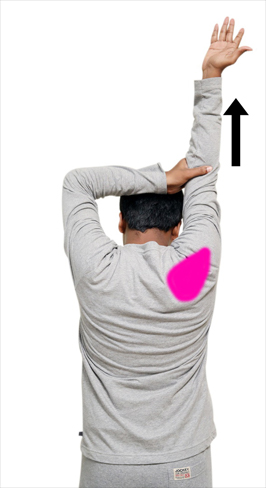
Steps for doing:
- The coloured part in being stretched
- Hold the right elbow straight and behind your head.
- Hold the elbow with left hand, thumb facing behind.
- Control the stretch behind the head, by pushing behind.
- Hold the same position for 10-20 seconds
In this video we are going to see subscapularis muscle stretching exercise
The coloured part in being stretched as shown
The arrow indicates the direction of stretch
- The key muscle in the frozen shoulder syndrome
- Symptoms refer to the scapula, shoulder, arm, and the wrist region
- Symptoms may include pain, numbness, hypersensitivity, compression of adjacent blood vessels and nerves
- Commonly related to disease such as rotator cuff tears, cervical nerve compression, capsulitis, various arthritis of shoulder joint and others.
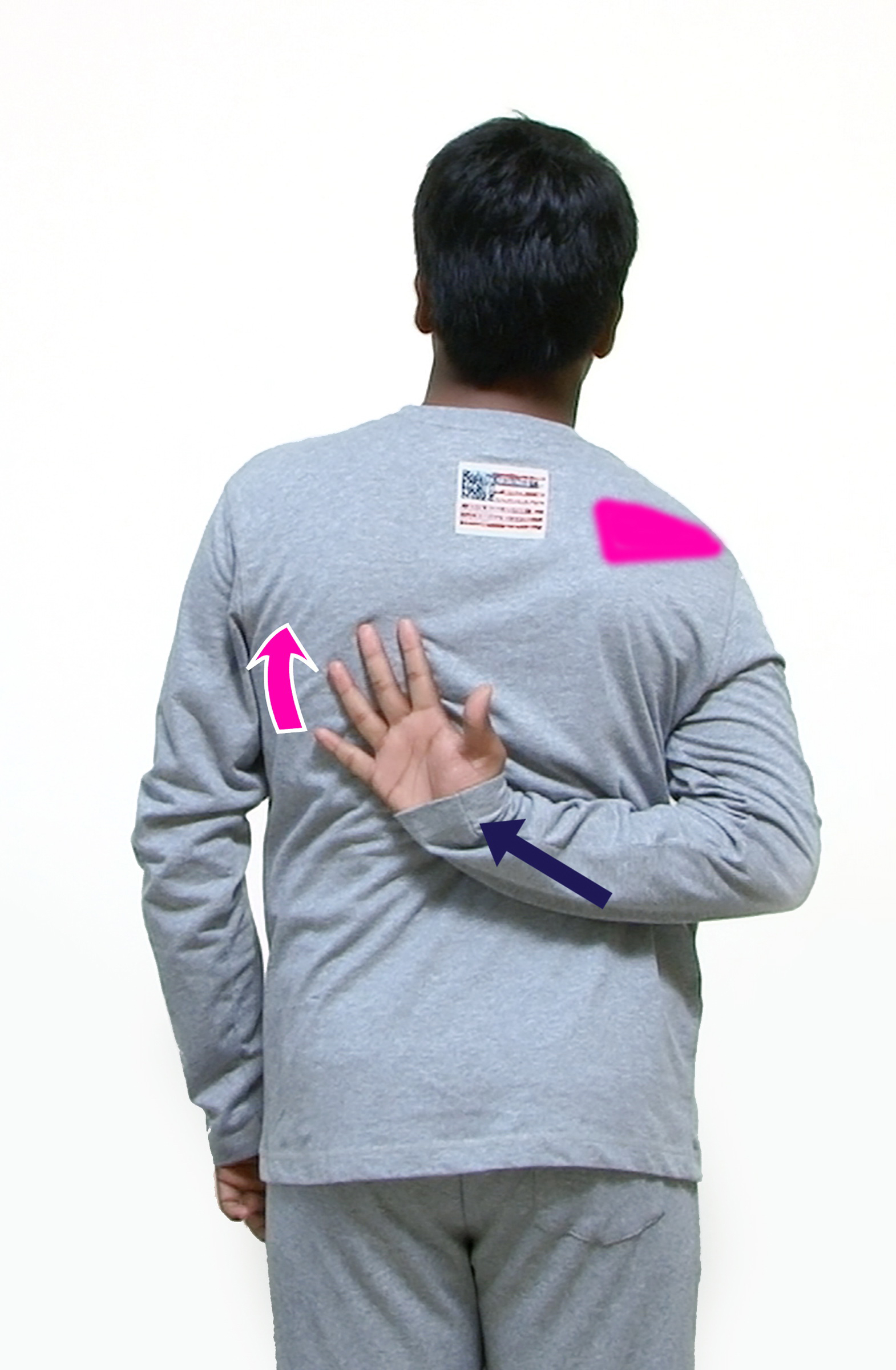
Steps for doing:
- The coloured part in being stretched
- Hold the right palm facing behind as shown
- Elbow abuts the body
- Move hand in upward direction & towards left for better stretch
- Hold the same position for 10-20 seconds
In this video we are going to see supra spinatus muscle stretching exercise
The coloured part in being stretched as shown
The arrow indicates the direction of stretch
- Most commonly related to rotator cuff injury
- Symptoms refer to shoulder, elbow, arm, and forearm regions
- Symptoms may include pain, numbness, hypersensitivity compression of adjacent blood vessels and nerves
- Commonly related to disease such as brachial plexus injury, cervical nerve compression, tendinitis, bursitis and other disease.
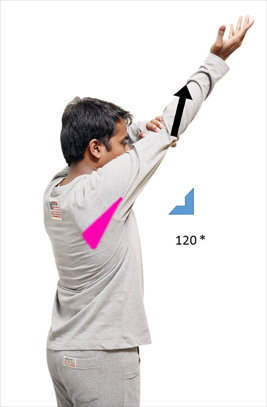
Steps for doing:
- The coloured part in being stretched
- Hold the Right upper limb as shown.
- See that right palm facing the sky.
- Hold the elbow with left hand, as shown
- With the left hand Pull right upper limb upwards and forward
- Hold the same position for 10-20 seconds
In this video we are going to see Teres major muscle stretching exercise
The coloured part in being stretched as shown
The arrow indicates the direction of stretch
- Muscle involved in rotator cuff injury
- Difficulty in reaching overhead
- Symptoms involve the shoulder joint, arm and fore arm regions
- Symptoms may include pain, numbness, hypersensitivity compression of adjacent blood vessels and nerves
- Commonly related to disease such as frozen shoulder, sub acromial bursitis, supraspinatus tendinitis, cervical nerve compression (C6,C7) and other disease.

Steps for doing:
- The coloured part in being stretched
- Hold your right hand behind your body
- Pull your head towards left as shown
- See that your left hand fully covers the right ear
- Your left ear should touch the left shoulder
- Keep your spine straight for better stretch
- Hold the same position for 10-20 seconds
In this video we are going to see upper trapezius muscle stretching exercise
The coloured part in being stretched as shown
The arrow indicates the direction of stretch
- It is the major muscle of the body holding the head, neck, upper spine, and the shoulder.
- It is the Most common cause for various headaches and various neck pain.
- It may cause symptoms involving the head, neck, upper spine, shoulder and upper limb region.
- Symptoms may include pain, numbness, hypersensitivity, compression of adjacent blood vessels and nerves.
- Commonly related to disease such as stiff neck, cervical disc prolapse, TMJ dysfunction, shoulder dysfunction, cervical spondylosis and others
 Brain and Spine Secrets
Brain and Spine Secrets